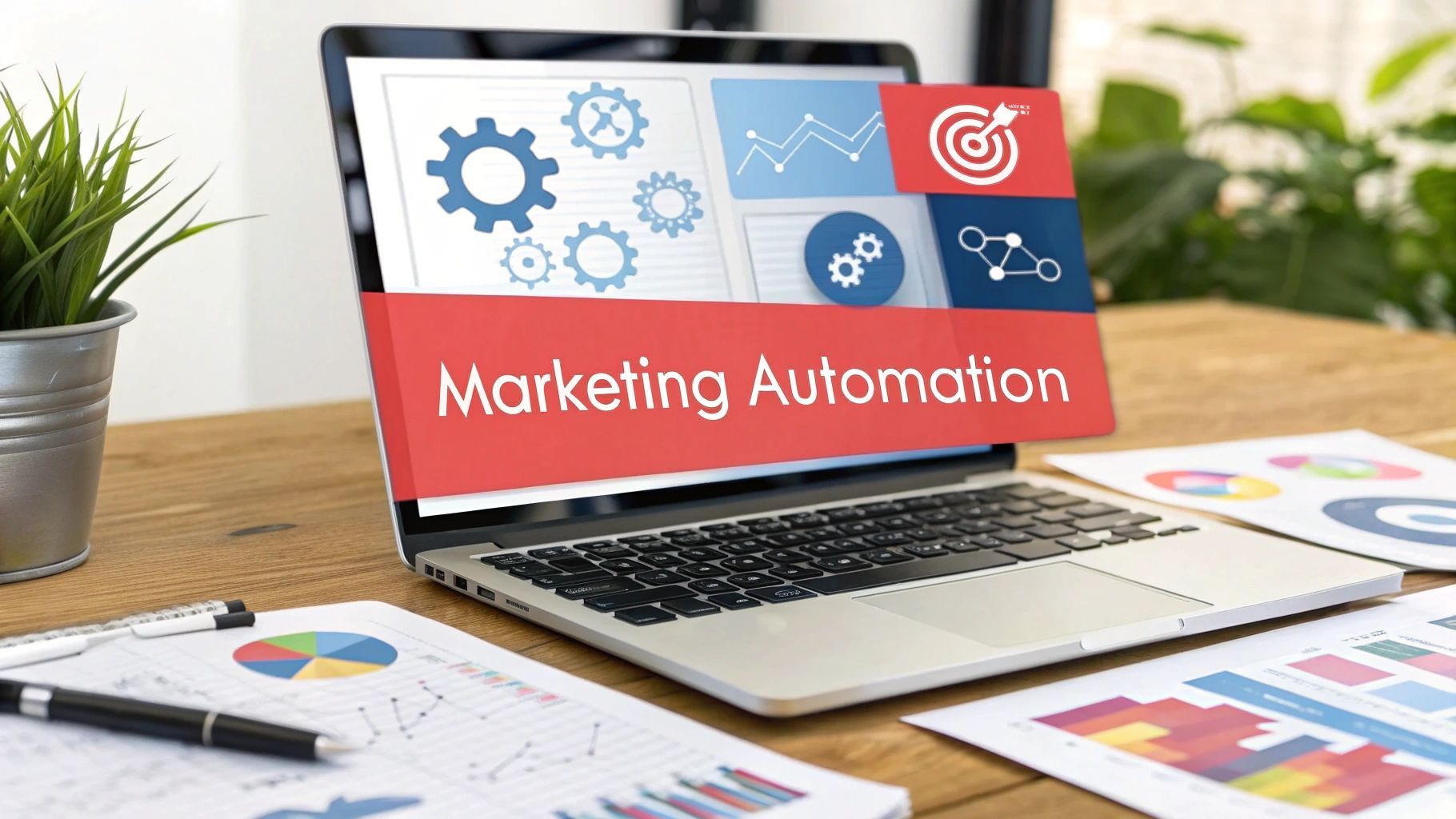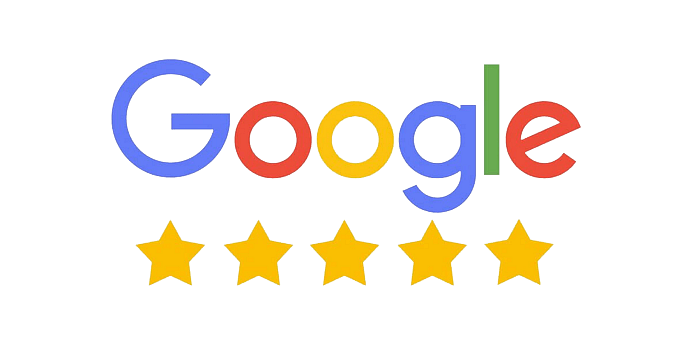9 Essential Digital Marketing for Tourism Strategies in 2025
The travel landscape has been reshaped by digital innovation. Today's tourists plan, book and share their journeys almost exclusively online, making a robust digital presence essential for survival and growth in this competitive sector. Navigating this space requires more than a basic website; it demands a sophisticated approach to digital marketing for tourism that connects with potential visitors at every stage of their decision-making process.
This guide moves beyond generic advice to provide a detailed look at nine powerful digital marketing strategies that can transform your reach and drive bookings. From mastering search engines with targeted SEO to leveraging the authentic voices of travellers through user-generated content, these techniques are designed for immediate impact. We will explore actionable steps and specific examples you can implement to attract, engage and convert the modern traveller.
Whether you are a boutique hotel, a tour operator or a regional destination, these insights will equip you with the tools to build a compelling online presence. Let us explore the precise strategies that will set your travel business apart in a crowded digital world, ensuring you capture the attention of your ideal audience and turn their travel dreams into confirmed reservations.
1. Search Engine Optimisation (SEO) for Tourism
Search Engine Optimisation (SEO) is the foundational practice of improving your website's visibility for relevant searches. For the travel sector this means ensuring your tour company, hotel or destination appears prominently when potential travellers search for information, inspiration and booking options. Effective digital marketing for tourism begins here, as a high ranking on Google can drive a consistent stream of organic, high-intent traffic directly to your digital doorstep.
Tourism SEO involves a multi-faceted approach. It goes beyond simple keywords to encompass local search optimisation, content creation that answers specific traveller queries and technical website enhancements. For example, a potential visitor is not just searching for “holidays in Cornwall”; they are looking for “family-friendly cottages in Cornwall with a sea view” or “best surfing spots near Newquay”. Capturing this specific intent is the key to attracting qualified leads.
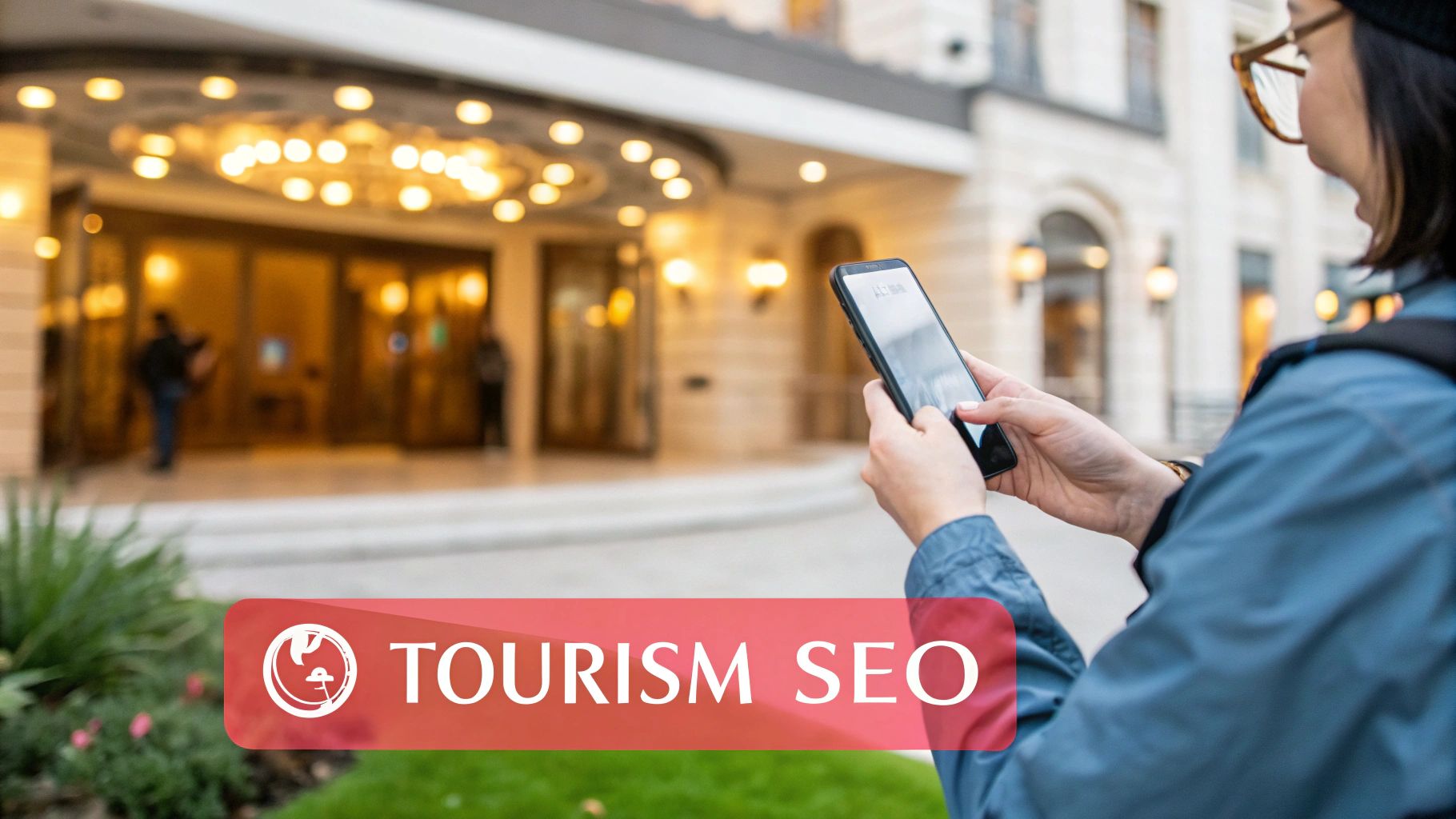
Why It's Crucial
Without a solid SEO strategy your business is invisible to the vast majority of travellers who start their journey on a search engine. Unlike paid advertising, SEO builds long-term authority and trust, delivering sustainable results and a higher return on investment over time. It allows you to compete with larger players by carving out a niche and becoming the go-to resource for specific travel interests.
Actionable Implementation Tips
- Target Long-Tail Keywords: Focus on highly specific, multi-word phrases that reflect user intent. Use tools like Ahrefs or Semrush to find queries like "guided walking tours Lake District for beginners" instead of just "Lake District tours".
- Optimise Google Business Profile: For hotels, attractions and tour operators a fully optimised Google Business Profile is non-negotiable. Ensure your address, hours, photos and services are accurate to dominate local "near me" searches.
- Create In-Depth Destination Guides: Develop comprehensive content that answers every possible question a traveller might have about your location. Think about transport, best times to visit, local etiquette and hidden gems. Visit Iceland’s content marketing is a masterclass in this, ranking for countless adventure travel keywords.
- Implement Structured Data: Use schema markup for events, hotels, tours and reviews. This helps search engines understand your content and can result in rich snippets (like star ratings and event dates) appearing directly in search results, boosting your click-through rate.
2. Social Media Marketing for Tourism
Social media marketing leverages visually-driven platforms like Instagram, TikTok and Facebook to inspire wanderlust and engage with travellers at every stage of their journey. For the travel industry it's about more than just posting pretty pictures; it’s about building a community, fostering authentic connections and turning followers into visitors. This form of digital marketing for tourism thrives on storytelling, showcasing unique experiences and tapping into the power of user-generated content to create social proof.
The core of tourism social media is visual appeal and interaction. It allows destinations, hotels and tour operators to showcase their offerings in a dynamic, engaging way that traditional advertising cannot match. A viral video of the Northern Lights from Visit Norway or an influencer's post from a unique Airbnb can generate more buzz and booking intent than a costly print campaign, demonstrating the immense power of peer-to-peer inspiration.
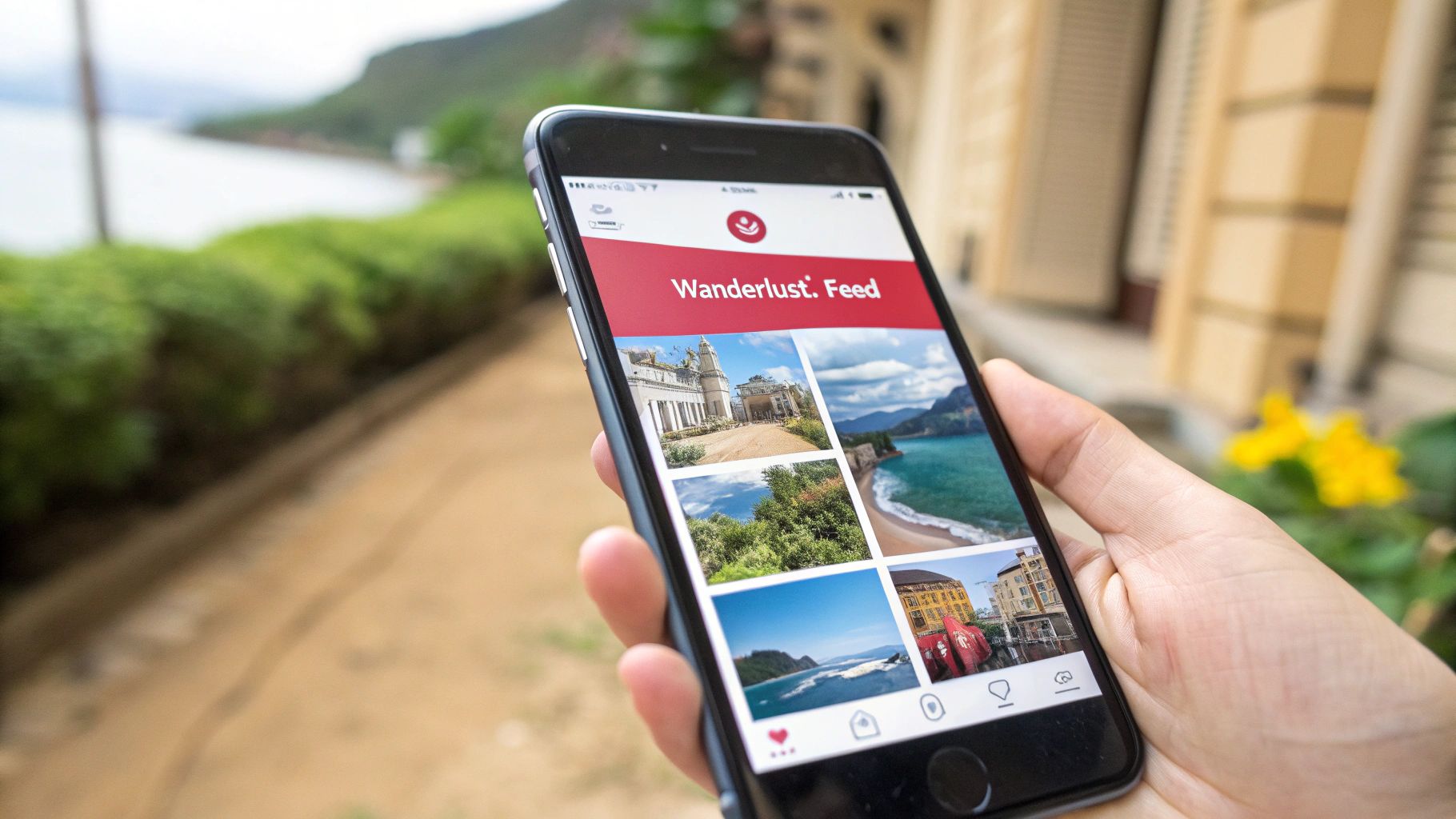
Why It's Crucial
In an industry built on experiences and recommendations social media is the digital word-of-mouth. Travellers actively seek inspiration and validation on these platforms, trusting user photos and reviews over polished marketing messages. An active and engaging social media presence builds brand personality, drives website traffic and provides a direct channel for customer service and real-time feedback.
Actionable Implementation Tips
- Encourage User-Generated Content (UGC): Create a unique, memorable hashtag and encourage guests to share their experiences. Tourism Australia’s iconic #SeeAustralia campaign is a masterclass, generating millions of authentic posts that serve as free, trusted advertising.
- Partner with Micro-Influencers: Collaborate with smaller, niche influencers whose audience aligns perfectly with your target traveller. Their endorsements often feel more authentic and deliver higher engagement rates than those from macro-celebrities.
- Utilise Location-Specific Features: Use geotags on all posts and encourage visitors to check in. This makes your content discoverable to people exploring your specific area on platforms like Instagram.
- Create ‘Shareable Moments’: Design your physical space or tour with social media in mind. Think about unique photo opportunities, beautiful backdrops or remarkable experiences that guests will be eager to capture and share with their followers.
3. Influencer Marketing for Tourism
Influencer marketing involves partnering with content creators, travel bloggers and social media personalities to promote destinations, accommodation and travel experiences. This powerful form of digital marketing for tourism leverages the authentic voice and established trust of an influencer to reach their engaged audience. It moves beyond traditional advertising by showing, not just telling, what makes a travel experience unique and desirable.
This strategy works because modern travellers seek genuine recommendations over polished corporate messages. They trust peer reviews and authentic content. When a respected travel influencer shares their journey through a destination it acts as a powerful, visual endorsement. Campaigns like Visit Finland's collaborations for its Northern Lights tours or Tourism New Zealand’s work with adventure creators showcase how influencers can drive significant interest and bookings.
The following diagram shows the different tiers of influencers that tourism brands can partner with, based on their follower count.
This hierarchy illustrates that while macro-influencers offer the broadest reach, micro and nano-influencers often provide higher engagement and a more targeted audience for niche travel brands.
Why It's Crucial
In a crowded digital landscape influencer marketing cuts through the noise. It provides access to a pre-built, targeted community that is already interested in travel. This approach builds brand credibility and generates user-generated content that can be repurposed across your own marketing channels. It is one of the most effective ways to inspire wanderlust and drive direct consideration for your brand.
Actionable Implementation Tips
- Focus on Micro-Influencers: These creators (typically 10k-100k followers) often have higher engagement rates and a more dedicated niche audience. Their recommendations can feel more personal and lead to better conversion rates for specialised tours or boutique hotels.
- Prioritise Creative Freedom: Provide influencers with clear campaign goals and key messages but allow them the creative freedom to produce content in their own style. This ensures the promotion feels authentic to their audience.
- Build Long-Term Partnerships: Instead of one-off campaigns, develop ongoing relationships with a select group of influencers. This turns them into genuine brand ambassadors who can tell a richer, more compelling story about your destination over time.
- Track Performance with Unique Codes: To measure ROI, provide each influencer with unique discount codes or trackable affiliate links. This allows you to directly attribute bookings and revenue to specific campaigns and creators. To streamline this process, consider partnering with a travel influencer agency that specialises in connecting brands with relevant creators.
4. Content Marketing for Tourism
Content marketing is the art of creating and distributing valuable, relevant and inspiring content to attract and engage a clearly defined audience. In the context of digital marketing for tourism this means moving beyond direct sales pitches to become a trusted source of travel information. It involves crafting destination guides, travel blogs, videos and itineraries that answer traveller questions and fuel their desire to explore, ultimately guiding them towards your services.
This strategy positions your brand as an authority, building a relationship with potential customers long before they are ready to book. For instance, a tour operator in Scotland could create content around “best hikes in the Cairngorms” or “a foodie’s guide to Edinburgh”. This approach attracts travellers during their initial inspiration phase, making your brand the natural choice when they decide to make a purchase.
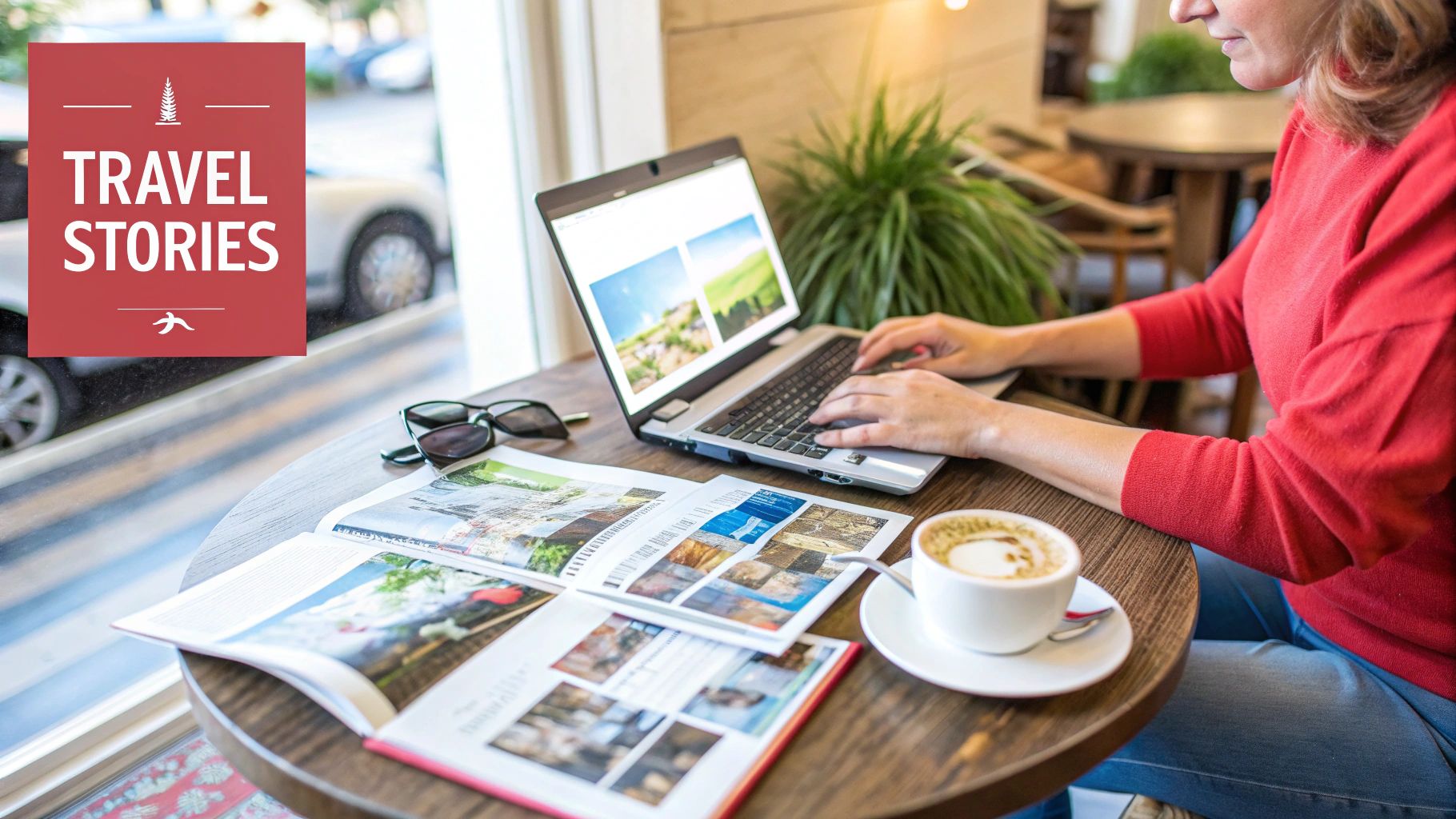
Why It's Crucial
Content marketing builds trust and credibility in a way that traditional advertising cannot. By providing genuine value upfront you foster a loyal community that sees you as more than just a business. This long-term approach generates organic traffic, improves your SEO performance and provides assets that can be repurposed across social media, email newsletters and other channels, maximising your marketing reach.
Actionable Implementation Tips
- Map Content to the Traveller's Journey: Create different types of content for each stage. Use inspiring "Top 10" lists for the awareness phase, detailed "how-to" guides for planning and practical checklists or packing lists for those nearing their booking decision.
- Leverage Local Expertise: Feature interviews with local guides, chefs or artisans to add authenticity and unique perspectives to your content. This provides genuine insight that travellers cannot find elsewhere and builds a strong connection to the destination.
- Optimise for "Question" Keywords: Focus on answering specific questions that travellers type into search engines. Use tools like AlsoAsked or AnswerThePublic to find queries like "what is the best month to visit the Isle of Skye?" and create content that directly answers them.
- Repurpose and Distribute: Turn a comprehensive blog post into a series of social media tips, a short video, an infographic or a podcast episode. The evolution of content marketing shows that multi-format distribution is key to reaching wider audiences.
5. Email Marketing for Tourism
Email marketing is a powerful direct communication channel for nurturing relationships with potential and past travellers. In the travel sector this involves sending targeted campaigns that go far beyond simple promotions. It's about delivering value at every stage of the customer journey, from initial inspiration and booking confirmations to post-trip follow-ups and loyalty offers. Effective digital marketing for tourism leverages email to keep your brand top-of-mind and drive repeat business.
This strategy thrives on personalisation and relevance. An email can deliver tailored destination guides, exclusive deals based on a user's browsing history or helpful pre-travel tips. For instance, a tour operator can send an automated email with a packing list a week before departure or an airline can send targeted flight deals to a subscriber’s favourite destinations. This level of personalised contact builds trust and transforms one-time bookers into loyal advocates for your brand.
Why It's Crucial
Unlike social media, where algorithms control reach, email gives you a direct line to your audience. It consistently delivers one of the highest returns on investment in digital marketing because it engages a self-selected group of interested individuals. For tourism businesses it is the ideal tool for driving direct bookings, reducing reliance on online travel agents (OTAs) and their commission fees and building a loyal customer base that returns year after year.
Actionable Implementation Tips
- Segment Your Audience Lists: Group contacts based on travel history, destination interests or booking behaviour. For example, create segments for "family travellers", "adventure seekers" or "past visitors to Scotland" to send hyper-relevant content.
- Automate Triggered Campaigns: Set up automated emails based on user actions. Send a welcome series to new subscribers, booking confirmation details and "abandoned cart" reminders for incomplete flight or hotel reservations.
- Craft Compelling Subject Lines: Use curiosity, urgency or personalisation to boost open rates. A subject line like "Your personalised guide to the Amalfi Coast awaits" is far more effective than "Monthly Newsletter".
- Provide Genuine Value: Go beyond sales pitches. Share inspiring travel stories, useful destination guides, tips from locals or exclusive content. This builds your reputation as a trusted travel expert. For more detailed strategies, you can learn more about personalisation in email marketing on superhub.biz.
6. Pay-Per-Click (PPC) Advertising for Tourism
Pay-Per-Click (PPC) advertising is a powerful digital marketing tool that allows tourism businesses to place ads on search engine results pages, social media platforms and other websites. You only pay a fee each time one of your ads is clicked, offering a direct way to buy visits to your site. For the tourism industry this means capturing high-intent travellers at the very moment they are searching for destinations, flights, accommodation or tours.
This strategy complements organic efforts like SEO by providing immediate visibility for competitive keywords. A well-organised PPC campaign can drive bookings during peak seasons, promote last-minute deals and reach specific demographics with precision. For example, a luxury resort can target users searching for "five-star spa hotels in the Cotswolds", ensuring their ad appears directly in front of a relevant and motivated audience. This immediate impact is a key component of a comprehensive digital marketing for tourism strategy.
Why It's Crucial
While SEO builds long-term value, PPC delivers speed and control. It allows you to turn traffic on and off as needed, test different offers and messages and generate valuable data on which keywords convert best. In the fast-paced travel market PPC enables businesses to react swiftly to changes in demand, competitor actions and seasonal trends, securing bookings that might otherwise be lost.
Actionable Implementation Tips
- Use Geotargeting and Scheduling: Focus your budget on specific countries, cities or even postcodes where your target audience lives. Schedule ads to run at times when potential customers are most likely to be planning their trips, such as evenings and weekends.
- Create Compelling Ad Copy: Your ad is your digital billboard. Use powerful verbs, highlight unique selling points (e.g. "Free Airport Transfer" or "Stunning Sea Views") and include a clear call-to-action like "Book Your Escape Today!".
- Implement Negative Keywords: Prevent wasted ad spend by creating a list of negative keywords. For example, a luxury tour operator should add terms like "cheap" and "budget" to ensure their ads are not shown to users seeking low-cost options.
- Utilise Ad Extensions: Enhance your ads with extensions to provide extra information directly in the search results. Sitelink extensions can direct users to specific tour pages, price extensions can display costs and call extensions allow mobile users to phone you with a single tap.
7. Video Marketing for Tourism
Video marketing is a powerful tool in the tourism industry, leveraging moving images to convey emotion, showcase experiences and inspire travel in a way static content cannot. For the travel sector this involves creating immersive content that transports potential visitors to a destination before they book. A well-crafted video can be the deciding factor in a traveller’s journey, making it a cornerstone of modern digital marketing for tourism by building a deep, emotional connection with the audience.
This strategy goes far beyond simple promotional clips. It encompasses everything from cinematic destination showcases and 360-degree virtual tours to authentic travel vlogs and short-form social media content. For example, a potential tourist is not just looking for a hotel; they want to feel the atmosphere of the lobby, see the view from the balcony and imagine themselves relaxing by the pool. Video marketing makes this virtual experience possible, effectively selling the dream before the ticket is purchased.
Why It's Crucial
In a visually driven market video content is essential for capturing attention and communicating the unique value of a travel experience. It is highly shareable across social platforms, increasing brand reach and engagement exponentially. Campaigns like Tourism Australia's Dundee promotion show how video can blend entertainment with marketing to create a global phenomenon, generating unparalleled interest and driving bookings far more effectively than traditional methods.
Actionable Implementation Tips
- Optimise for Social Media: Keep videos for platforms like Instagram and TikTok short and engaging, ideally under two minutes. Design them for vertical, mobile viewing and always include captions for accessibility and silent watchers.
- Embrace Authenticity: Use local music and authentic voices to create a genuine sense of place. User-generated content or collaborations with travel vloggers can add a layer of trust and credibility that professionally produced content sometimes lacks.
- Showcase, Don’t Just Tell: Create virtual tours of your hotel rooms, guided walkthroughs of a local attraction or a first-person view of an adventure activity. Let viewers experience the destination for themselves, helping them overcome hesitation.
- Create Platform-Specific Versions: Edit your core video content into different formats for different channels. A longer, cinematic version might work for YouTube, while a fast-paced, 15-second clip is better suited for an Instagram Story. You can discover more about the power of video marketing in the digital age.
8. User-Generated Content (UGC) Marketing for Tourism
User-Generated Content (UGC) marketing involves encouraging and leveraging the authentic photos, videos and reviews created by travellers to promote your destination or business. In the tourism sector this content serves as powerful social proof, showcasing real experiences from the perspective of actual guests. A strong digital marketing for tourism plan integrates UGC to build trust and community far more effectively than traditional brand messaging.
This strategy transforms your audience from passive consumers into active brand advocates. When a potential customer sees a peer enjoying your hotel, tour or destination it resonates more deeply than a polished advertisement. Campaigns like GoPro’s adventure travel content, built almost entirely from user submissions, demonstrate how UGC can fuel a brand’s entire marketing engine with genuine, compelling and diverse content.
Why It's Crucial
UGC is the digital equivalent of word-of-mouth marketing at scale. It provides a constant stream of fresh, credible and cost-effective content that builds authenticity and relatability. For tourism brands it provides a window into the genuine guest experience, helping prospective travellers visualise themselves in your location and overcome booking hesitation. For businesses wanting to understand this space better, this guide to becoming a travel UGC creator offers valuable insights into the creator perspective.
Actionable Implementation Tips
- Create a Memorable Hashtag: Develop a unique and catchy hashtag for your destination or brand (e.g. #VisitYourTown) and promote it across all channels, from hotel key cards to social media bios, to collate content.
- Run Contests and Offer Incentives: Encourage high-quality submissions by running photo or video contests with attractive prizes like a free stay, a tour upgrade or travel vouchers. This gamifies the content creation process.
- Always Ask for Permission: Before reposting a guest’s content on your official channels always reach out to ask for permission. This respects the creator and avoids potential legal issues, while also building goodwill.
- Feature UGC Prominently: Don’t just re-share UGC on social media. Integrate the best submissions into your website galleries, email newsletters and even print brochures to maximise their impact and show your appreciation.
9. Mobile Marketing for Tourism
Mobile marketing for tourism capitalises on the fact that travellers are almost always connected via their smartphones. This strategy involves reaching tourists through mobile-optimised websites, dedicated apps, SMS campaigns and location-based services. With travellers using their phones for everything from initial research and booking to on-the-ground navigation and sharing experiences, a mobile-first approach is no longer optional in digital marketing for tourism .
The core of this strategy is convenience and immediacy. It recognises that the modern tourist journey happens in micro-moments on a small screen. For example, a tourist might use a mobile app like TripAdvisor to find a nearby restaurant with good reviews or receive a push notification from a travel provider with a last-minute tour offer based on their current location. This real-time, context-aware engagement is what makes mobile marketing so powerful for the travel sector.
Why It's Crucial
Your audience is on mobile, making it the primary channel for engagement throughout their entire trip. A clunky, non-optimised mobile experience can lead to immediate frustration and lost bookings. Conversely a seamless mobile strategy enhances the customer experience, driving loyalty and positive reviews. It allows you to be a helpful companion to the traveller, providing value precisely when and where they need it most.
Actionable Implementation Tips
- Prioritise Mobile-First Website Design: Ensure your website is fully responsive and loads quickly on mobile devices. All navigation, text and booking forms must be easy to use on a small touchscreen. Google’s Mobile-Friendly Test is an excellent starting point.
- Leverage Geofencing and Beacons: Use location-based technology to send targeted messages. A museum could send a welcome notification to visitors who enter, while a tour operator could push a last-minute discount to users within a one-mile radius of their departure point.
- Simplify the Booking Process: Mobile booking forms should be minimalist, requesting only essential information. Integrate mobile payment options like Apple Pay and Google Pay to reduce friction and make impulse bookings easier.
- Develop an App with Offline Functionality: If you create a mobile app, consider how it will function without a reliable internet connection. Providing offline maps, itineraries and key information is a significant value-add for international travellers avoiding high data roaming charges.
Digital Marketing Strategies Comparison for Tourism
| Marketing Strategy | Implementation Complexity 🔄 | Resource Requirements ⚡ | Expected Outcomes 📊 | Ideal Use Cases 💡 | Key Advantages ⭐ |
|---|---|---|---|---|---|
| Search Engine Optimisation (SEO) | Medium to high; ongoing optimisation needed 🔄 | Content creation, technical SEO skills ⚡ | Sustainable organic traffic growth 📊 | Long-term brand building, capturing high-intent travellers 💡 | Cost-effective, builds trust, local search advantages ⭐ |
| Social Media Marketing | High; continuous content and community management 🔄 | Visual content creation, influencer collaboration ⚡ | High engagement and brand loyalty 📊 | Visual storytelling, community building 💡 | Direct audience engagement, cost-effective reach ⭐ |
| Influencer Marketing | Medium; partnership management and monitoring 🔄 | Influencer payments, content coordination ⚡ | Increased brand awareness and authentic reach 📊 | Authentic promotion via trusted voices 💡 | High authenticity, targeted audiences, quality content ⭐ |
| Content Marketing | High; significant time for content creation 🔄 | Multi-format content production, SEO skills ⚡ | Builds authority, educates and nurtures leads 📊 | Inspiring and practical travel guidance 💡 | Supports SEO, evergreen content, brand authority ⭐ |
| Email Marketing | Medium; segmentation and automation setup 🔄 | Email marketing tools, content personalisation ⚡ | High ROI and direct bookings 📊 | Personalised communication, nurturing leads 💡 | High ROI, direct contact, builds relationships ⭐ |
| Pay-Per-Click (PPC) Advertising | Medium to high; requires ongoing optimisation 🔄 | Budget for ads, campaign management tools ⚡ | Immediate visibility and bookings 📊 | Short-term high-intent customer capture 💡 | Precise targeting, measurable ROI, fast results ⭐ |
| Video Marketing | High; production and editing resource intensive 🔄 | Video equipment, skilled creators ⚡ | Highly engaging and immersive content 📊 | Showcasing destinations emotionally 💡 | Emotional impact, SEO boost, shareability ⭐ |
| User-Generated Content (UGC) | Medium; community engagement and moderation 🔄 | Community management, incentive programmes ⚡ | Authentic content and increased brand reach 📊 | Social proof, community-driven content 💡 | Cost-effective, authentic, builds engagement ⭐ |
| Mobile Marketing | Medium to high; app development and optimisation 🔄 | App development, mobile-friendly content ⚡ | Real-time, personalised traveller engagement 📊 | Location-based offers, on-trip engagement 💡 | High engagement, real-time communication ⭐ |
Integrating Your Strategies for a Seamless Traveller Journey
Navigating the landscape of digital marketing for tourism can feel like plotting a course through a vast, uncharted wilderness. We have explored a multitude of powerful strategies, from the foundational authority-building of Search Engine Optimisation to the vibrant, real-time engagement of social media and the authentic storytelling of influencer collaborations. We have delved into the nurturing power of email marketing, the immediate impact of Pay-Per-Click campaigns and the immersive potential of video. Each of these elements, from leveraging user-generated content to optimising for mobile, represents a vital touchpoint in the modern traveller's decision-making process.
However, the true mastery of digital marketing for tourism does not lie in executing these tactics in isolation. The real transformative power emerges when you weave them together into a single, cohesive ecosystem. Your SEO efforts should inform your content marketing, creating articles and guides that not only rank well but also provide genuine value that you can then promote via your social media channels and email newsletters. The stunning visuals you create for your video marketing can be repurposed into compelling social media clips or integrated into your PPC landing pages to boost conversions.
From Silos to Synergy: Creating a Unified Experience
Think of it as creating a seamless journey for your potential customers. A traveller might first discover your destination through a captivating influencer post on Instagram. Intrigued, they might search for more information, finding your well-optimised blog post about "the best things to do in [your location]". From there they might sign up for your newsletter to receive a free travel planner, entering an email sequence that nurtures their interest with personalised offers and inspiring stories. Later, a targeted PPC advert could remind them of a special package, prompting them to finally book their trip on your mobile-friendly website.
This integrated approach ensures your brand is present, helpful and consistent at every stage. It transforms disparate marketing actions into a unified conversation that guides the traveller from the first spark of inspiration right through to becoming a loyal advocate who shares their own experiences online. By breaking down the silos between your SEO, content, social and advertising efforts you create a powerful, self-reinforcing marketing engine that delivers sustained growth and a superior customer experience. This holistic view is the cornerstone of effective digital marketing for tourism today.
Ready to unify your marketing efforts and create a seamless journey for your travellers? The team at Superhub specialises in developing integrated digital marketing strategies for the tourism, automotive and motorsport sectors. Contact us to discover how our expertise can help you connect with your audience and drive exceptional results.



